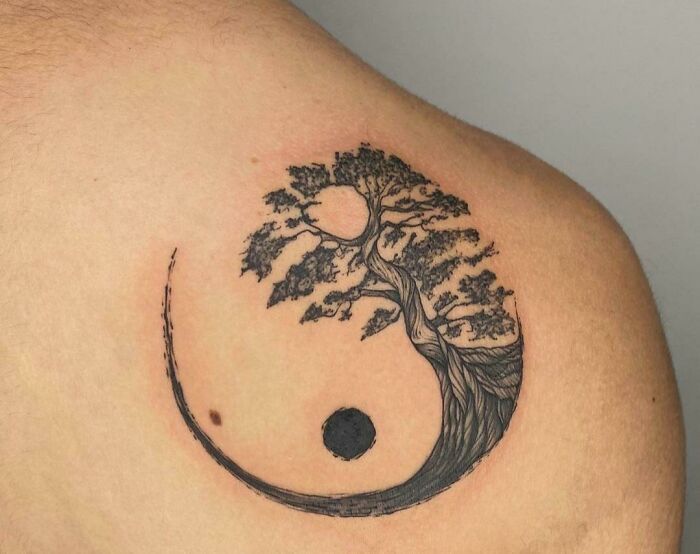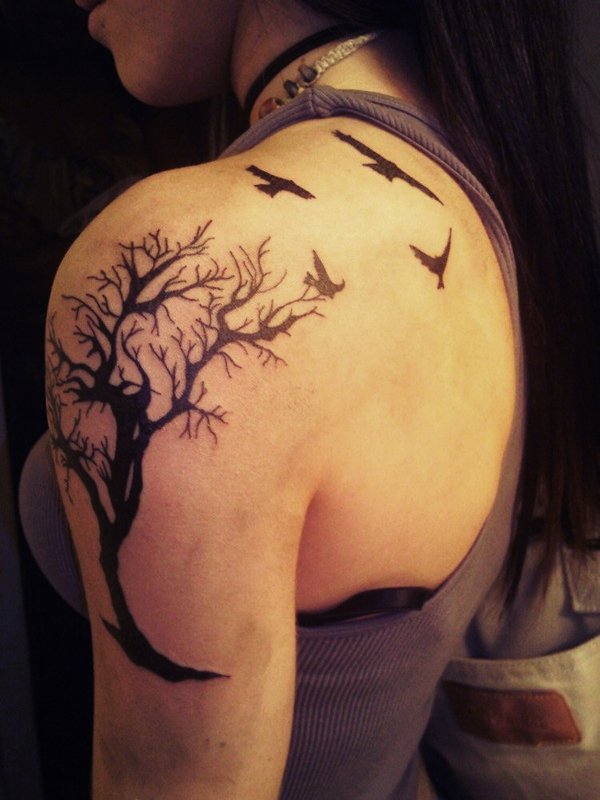The Tree of Life, a symbol deeply rooted in ancient cultures and mythology, has transcended time and borders to become a popular choice for tattoos across the globe. Its intricate and symbolic design, often featuring intricate branches, roots, and a central trunk, represents a connection between heaven, earth, and the underworld, serving as a powerful metaphor for life's cycles and the interconnectedness of all living beings.
The Symbolic Significance of Tree of Life Tattoos

Tree of Life tattoos hold a unique allure for those seeking to embody the deep symbolism embedded in this ancient icon. The tattoo’s appeal lies in its multifaceted representation of life’s complexities. Each element of the tree holds a special meaning: the roots symbolize our connection to our ancestors and the past, the trunk represents the present, and the branches and leaves stretch towards the future, symbolizing growth, evolution, and the endless possibilities that lie ahead.
In many cultures, the Tree of Life is revered as a symbol of strength, resilience, and the circle of life. It signifies the interconnectedness of all living beings and the idea that life is an eternal cycle of birth, growth, and rebirth. The tattoo serves as a constant reminder of this profound concept, offering wearers a daily dose of inspiration and a deeper connection to the natural world.
A Global Symbol with Local Interpretations
The Tree of Life symbol has a rich and diverse history, with variations and interpretations found across numerous cultures and belief systems. In Norse mythology, the Yggdrasil is often depicted as a massive ash tree, serving as a link between the nine worlds and a representation of the cosmos. Celtic traditions also feature the Tree of Life, with intricate knotwork designs symbolizing the interconnectedness of all life and the cycle of birth, death, and rebirth.
In many indigenous cultures, the Tree of Life is a sacred symbol, representing the harmony and balance of nature. It often serves as a bridge between the physical and spiritual realms, with its branches reaching towards the heavens and its roots firmly planted in the earth.
| Cultural Interpretation | Symbolism |
|---|---|
| Norse Mythology | Link between worlds, representation of the cosmos |
| Celtic Traditions | Interconnectedness of life, cycle of birth and rebirth |
| Indigenous Cultures | Harmony and balance of nature, bridge between physical and spiritual realms |

Artistic Interpretations and Tattoo Designs

Tattoo artists have embraced the Tree of Life as a canvas for their creativity, resulting in an incredible array of artistic interpretations. From minimalist designs to highly detailed, full-body pieces, the Tree of Life tattoo showcases the diverse styles and techniques within the tattooing art form.
Traditional vs. Modern Styles
Traditional Tree of Life tattoos often feature bold, black lines and minimal shading, focusing on the tree's structural elements. These tattoos tend to be more symbolic and less intricate, emphasizing the tree's roots, trunk, and branches. On the other hand, modern designs often incorporate vibrant colors, intricate details, and unique elements like flowers, birds, or even celestial bodies, adding a contemporary twist to this ancient symbol.
Unique Design Elements
Many tattoo artists and wearers choose to incorporate personal touches into their Tree of Life tattoos. This might include adding names or dates to the tree's roots or branches, symbolizing the importance of family and personal milestones. Some designs might also feature specific elements that hold personal significance, such as favorite flowers, animals, or celestial symbols.
Incorporating other cultural symbols or art styles can also add depth and meaning to the tattoo. For instance, a Tree of Life tattoo inspired by Japanese art might feature delicate cherry blossoms or koi fish swimming among the roots, merging the symbolism of the Tree of Life with the beauty and meaning of Japanese culture.
Choosing the Right Placement for Your Tree of Life Tattoo
The placement of a Tree of Life tattoo is a crucial decision, as it can significantly impact the overall aesthetic and meaning of the design. Some popular choices include:
- Arm or shoulder: This placement allows for a larger, more detailed design and is a great choice for those who want to showcase their tattoo proudly.
- Back: A full back tattoo can accommodate an impressive, intricate Tree of Life design, often with added elements to fill the surrounding space.
- Leg: Tree of Life tattoos on the leg offer a unique, eye-catching placement, especially when designed to wrap around the calf or thigh.
- Chest or stomach: These placements can be powerful and intimate, especially for designs that hold personal significance.
It's important to consider the size and detail of your desired design when choosing a placement. Larger, more detailed tattoos will require more space and may be more comfortable on certain areas of the body.
Caring for Your Tree of Life Tattoo
Proper aftercare is crucial to ensure your Tree of Life tattoo heals beautifully and maintains its vibrant appearance. Here are some essential tips:
- Keep the tattoo clean and moisturized, following your tattoo artist's aftercare instructions.
- Avoid direct sunlight and tanning beds, as these can fade and damage your tattoo.
- If swimming or bathing, ensure the tattoo is fully healed before submerging it in water.
- Regular touch-ups by a professional tattoo artist can help maintain the tattoo's original vibrancy and detail.
The Lasting Impact of Tree of Life Tattoos

Tree of Life tattoos are more than just ink on skin; they are a powerful statement of one's connection to the natural world and the deeper meanings of life. Whether as a personal reminder of resilience and growth or as a symbol of cultural heritage, these tattoos carry a weight of significance that extends far beyond their aesthetic appeal.
As a popular and timeless choice, Tree of Life tattoos continue to evolve and inspire, reflecting the diverse stories and experiences of those who choose to wear them. Through their intricate designs and rich symbolism, these tattoos serve as a beautiful tribute to the enduring power of nature and the human spirit.
Frequently Asked Questions
What does a Tree of Life tattoo symbolize?
+A Tree of Life tattoo symbolizes the interconnectedness of all living beings, representing the circle of life and the eternal cycles of birth, growth, and rebirth. It is a powerful symbol of strength, resilience, and our connection to nature and our ancestors.
How do I choose a design for my Tree of Life tattoo?
+When choosing a design, consider your personal connection to the symbol. Think about the elements you want to include, such as specific flowers, animals, or cultural symbols. Discuss your ideas with a reputable tattoo artist who can help bring your vision to life.
Are Tree of Life tattoos suitable for all body parts?
+Tree of Life tattoos can be adapted to various body parts, but the size and detail of your design will influence the best placement. Larger designs are better suited for areas like the back, arms, or legs, while smaller, more intimate designs can be placed on the wrist, ankle, or behind the ear.
How do I care for my Tree of Life tattoo?
+Proper aftercare is essential for the healing and longevity of your tattoo. Keep it clean, moisturized, and protected from the sun. Follow your tattoo artist’s aftercare instructions, and consider using specialized tattoo creams and sunscreens for optimal care.